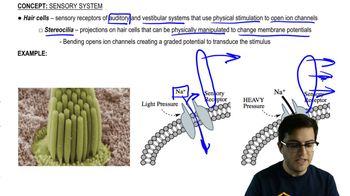Textbook Question
The middle ear converts a. air pressure waves to fluid pressure waves. b. air pressure waves to nerve impulses. c. fluid pressure waves to nerve impulses. d. pressure waves to hair cell movements.
877
views
 Verified step by step guidance
Verified step by step guidance



The middle ear converts a. air pressure waves to fluid pressure waves. b. air pressure waves to nerve impulses. c. fluid pressure waves to nerve impulses. d. pressure waves to hair cell movements.
During the contraction of a vertebrate skeletal muscle fiber, calcium ions a. break cross-bridges as a cofactor in hydrolysis of ATP. b. bind with troponin, changing its shape so that the myosin-binding sites on actin are exposed. c. transmit action potentials from the motor neuron to the muscle fiber. d. spread action potentials through the T tubules.